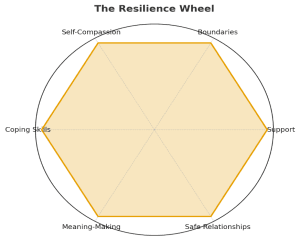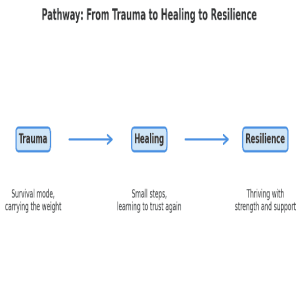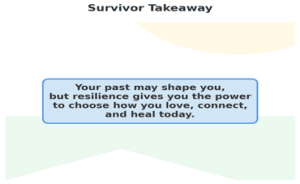Trauma doesn’t just live in the past — it often shows up in how we love, trust, and connect today. If you’ve ever wondered why relationships feel harder than they “should,” you’re not alone. This blog explores how trauma affects relationships, why resilience after abuse is possible, and how healing family wounds can open the door to healthier, stronger bonds.
If you’ve been through hard things, it makes sense that relationships don’t always feel easy. Trauma has a way of sneaking into our closest bonds — even years later. You might pull away when someone gets too close, get anxious if they don’t text back, or feel like family ties are more complicated than they “should” be.
Trauma changes how we see ourselves, other people, and what love feels like. But here’s the hope — none of this is permanent. With time, support, and resilience, it’s possible not only to heal old wounds but also to build healthier, stronger relationships.
How Trauma Shows Up in Relationships
Let’s make this real.
- Maybe you grew up in a home where love and fear lived side by side. Now, when a partner raises their voice, even a little, your whole body goes on high alert. That’s trauma talking.
- Or perhaps someone neglected you, leaving you to figure things out alone. As an adult, you might swing between craving closeness and pushing people away.
- In family life, old wounds can show up as constant conflict with siblings, struggles with parenting, or repeating patterns that once hurt you.
Research backs this up. A recent study found that childhood trauma lowers relationship satisfaction by making it harder to feel secure with others. But you probably don’t need a study to tell you what you’ve already lived — that trust, intimacy, and safety can feel fragile after trauma.
Why Resilience Matters?
Here’s the good news: trauma may leave a mark, but resilience helps us rewrite the story.
Resilience isn’t about “bouncing back” or pretending things didn’t hurt. It’s about adapting — learning how to bend without breaking. And survivors are some of the most resilient people I know.

The Resilience Wheel: simple building blocks for recovery and healthier bonds.
Think of resilience as:
- Support: a friend who listens without judgment, a therapist who understands trauma, or even a safe online group.
- Skills: grounding exercises when you’re triggered, learning how to name your needs, or practicing self-compassion.
- Meaning: making sense of what happened — whether through faith, creativity, advocacy, or personal growth.
Studies show that survivors who have vigorous support and coping tools often have fulfilling relationships. You don’t have to carry the past into every bond — resilience gives you alternative choices.
Healing Family Wounds
Family is often where the deepest scars come from — and where the hardest healing happens.
Maybe you grew up in silence, with no one speaking about what was really happening. Maybe there was emotional neglect, or worse, abuse. Those wounds don’t just disappear when we grow up; they echo in how we relate to our families and even in how we parent.
But healing family wounds is possible.
- Breaking the cycle: If you grew up with poor boundaries, you could choose to set new ones in your own home.
- Repairing relationships: Sometimes this means honest conversations, therapy, or naming what happened.
- It is essential to choose peace over constant hurt, and accepting limitations in certain family ties is required for healing.
One study found that people who experienced neglect were more likely to fall into codependent relationships — but resilience reduced this risk. Therefore, the patterns don’t determine the future.

This pathway shows how we move from carrying the weight of trauma toward resilience and thriving.
Practical Ways to Build Healthier Bonds
Here are a few steps survivors often find helpful:
- Name it. Say out loud (even to yourself): “This is trauma, not me.” That awareness can stop shame in its tracks.
- Learn safe communication. Try using “I feel” statements instead of blame — e.g., “I feel anxious when I don’t hear from you” instead of “You don’t care about me.”
- Practice boundaries. Small steps count — saying no when you mean no, leaving conversations when they get heated, protecting your peace.
- Find your people. Not everyone deserves your story. Choose safe friends, groups, or professionals who support your healing.
- Offer yourself kindness. Trauma survivors are often harder on themselves than anyone else. Try talking to yourself the way you’d talk to someone you love.

Closing
Yes, trauma changes how relationships feel. But that’s not the end of the story. Resilience after abuse is real. Healing family wounds is possible. And you deserve bonds that are safe, supportive, and strong.
Remember — healing doesn’t mean erasing the past. It means building relationships that honour the person you’ve become. And you don’t have to do it alone.
Bibliography
- Quan, J., et al. (2024). The relationship between childhood trauma and romantic relationship satisfaction: attachment as mediator, social support as moderator. Frontiers in Psychiatry. https://doi.org/10.3389/fpsyt.2024.1519699
- Kairyte, M., et al. (2023). Trajectories of resilience in adolescents exposed to childhood maltreatment. Child and Adolescent Psychiatry and Mental Health, 17, 58. https://capmh.biomedcentral.com/articles/10.1186/s13034-023-00558-2
- Sippel, L. M., et al. (2024). Bidirectional associations between social support and PTSD symptoms: A longitudinal study. Journal of Traumatic Stress. https://pmc.ncbi.nlm.nih.gov/articles/PMC11047467/
- Abate, A., et al. (2024). Resilience after adversity: an umbrella review of protective factors following childhood adversity. Frontiers in Psychiatry. https://doi.org/10.3389/fpsyt.2024.1391312
- Kaya, C., et al. (2024). Childhood emotional abuse and neglect, resilience, and co-dependency: A mediation analysis. Children and Youth Services Review, 158. https://doi.org/10.1016/j.childyouth.2024.107559